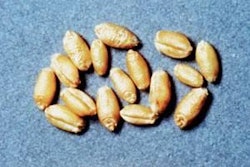
Sows in pig breeding herds around the world are at risk of receiving an under-supply of micro nutrients, according to evidence compiled in the USA. Many sow diets need to have extra vitamin supplementation unless the animals themselves can be fed on a different basis.
North American swine nutritionists say the difficulty has arisen over time because of the common practice of deciding the daily feed allowance of a pregnant sow on the basis of her body condition. The feeding schedule used in re-breeding and gestation typically follows a typical pattern (see figure 'Typical sow feeding'). So a level of about 4 kilograms per day is reduced to 2 kg soon after mating and will remain at that point until shortly before farrowing, apart from some initial adjustments deemed necessary to correct the sow from being either too thin or over-fat.
The compensatory amounts are judged by so-called condition scores. A standard scoring system would make the ideal sow a score-3 on a scale running from 1 (thin) to 5 (fat). Unfortunately, the score she receives takes no account of her age or parity status, nor does it consider her weight.
Nutrients by weight-backfat, not body score
That lack of a weight assessment is now reckoned a critical factor in failing to provide enough nutrients to certain individuals. It was discussed last year in the USA, at a Pork Academy session held before the World Pork Expo exhibition. Dr Frank Aherne of the University of Alberta in Canada drew attention to the difference in feeding level that would occur if sows were fed exclusively on the score of 3 given visually to their physical condition, rather than on his preferred basis of backfat thickness and estimated weight.
Using an example of feeding levels based on backfat and sow weight (see table), animals in a lightweight range of 115-140 kg, and measuring some 15-18 mm of backfat at mating, would receive 1.9 kg of feed per day. Medium-sized sows weighing 180-215 kg would receive 2.4 kg daily. Heavyweights of 250-300 kg could expect 2.8 kg/day because of their weight and backfat.
 sow-fig-1
sow-fig-1
A typical pattern of daily feed allowances for breeding sows offers some additional nutrition where appropriate after mating and also increases the amount as farrowing approaches. Source: Adapted from Aherne, 2005.
Contrast this weight-backfat regime, Dr Aherne remarked, with the strategy in which all sows are fed by condition score regardless of weight. Each of them would have the same feed intake. In such circumstances, every sow with a condition score of 3 most probably would be receiving about 2.3 kg of feed per daya difference in amount of up to 22% when compared with a weight-backfat regime.
Comparable calculations have been produced for the different trace mineral supplies that would reach sows under the two feeding strategies. Dr Aherne gave the example of an animal weighing between 250-300 kg and receiving a gestation diet in which there was 0.9% calcium and 0.75% phosphorus. We have already seen that feeding her exclusively on the score awarded to her physical condition could mean an allowance of 2.3 kg daily, whereas the weight-backfat regime would provide some 2.8 kg/day. In terms of daily calcium intake, Dr Aherne explained, the difference according to feeding method would be either 20.7 grams (condition score) or 26.1 grams (weight-backfat). For phosphorus, the figures become either 17.3 grams or 21.8 grams.
The trace mineral premix is also likely to be the source of vitamins, however. Ignoring weight when deciding on feed quantity similarly risks an under-supply of these micro nutrients to more mature sows.
Adequate vitamins, larger litters
A striking illustration of the consequences can be obtained from looking at practical studies in the USA by Dr Dean Boyd, who heads the nutrition team at pork production company Hanor. According to Dr Aherne's remarks to the Pork Academy, the work by Dr Boyd has demonstrated that a vitamins increase for older or geriatric' sows can mean an extra 1.0-1.5 pigs weaned per sow. His work shows details of the litter sizes recorded after vitamin-mineral intakes were equalised to take account of parity (see figure 'Micro nutrient equalisation').
 sow-fig-2
sow-fig-2
Sow feeding allowances (kg/day) based on backfat and estimated sow weight from Day 0 to Day 100. Source: Adapted from Young, 2004, with reference to Aherne, 2005.
The pattern of decreasing vitamin-mineral intake by age is dramatic (see figure ‘Vitamin and trace mineral'). It signals a rapid and substantial drop in the amount of micro nutrients per kilogram of sow bodyweight, as the sow becomes older and heavier, under regimes that maintain a set level of total feed per sow/day, without considering the animal's weight. While a first-litter animal might be consuming about 27 grams of vitamins and trace minerals per kilogram of her weight, by the time she reaches the third parity this will have dropped below 20 g/kg.
 sow-fig-3
sow-fig-3
A vitamins increase for older or geriatric' sows can mean an extra 1.0-1.5 pigs weaned per sow. Source: Boyd, 2004, with reference from Aherne, 2005.
Modern sows may be receiving less than 50% of a trace-mineral mix per kilogram of bodyweight compared with levels supplied previously, Dr Aherne added. The situation should be corrected, either through additional supplementation of the diet or by changing to a strategy of feeding pregnant sows based on their weight.
 sow-fig-4
sow-fig-4As shown with American hybrid sows, there is a rapid and substantial drop in the amount of micro nutrients per kilogram of sow bodyweight, as the sow becomes older and heavier. Source: Adapted from Aherne, 2005, based on PIC USA, 2002.















